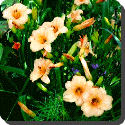 Day Lily — Daylilies comprise the small genus Hemerocallis of flowering plants in the family Hemerocallidaceae. They are not true lilies which are Lilium in Liliaceae.
Day Lily — Daylilies comprise the small genus Hemerocallis of flowering plants in the family Hemerocallidaceae. They are not true lilies which are Lilium in Liliaceae.
Daylilies are not commonly used as cut flowers for formal flower arranging, yet they make good cut flowers otherwise as new flowers continue to open on cut stems over several days.
Originally native from Europe to China, Korea, and Japan, their large showy flowers have made them popular worldwide. There are over 60,000 registered cultivars. Only a few cultivars are scented. Some cultivars rebloom later in the season, particularly if their developing seedpods are removed.
Daylilies occur as a clump including leaves, the crown, and the roots. The long, often linear lanceolate leaves are grouped into flat fans with leaves arching out to both sides. The crown of a daylily is the small white portion between the leaves and the roots, an essential part of the fan. Along the flower stem or scape, small leafy “proliferations” may form at nodes or in bracts. These proliferations form roots when planted and are the exact clones of the parent plant. Some daylilies show elongated widenings along the roots, made by the plant mostly for water storage and an indication of good health.
The flower consists of three petals and three sepals, collectively called tepals, each with a midrib in the same or in a contrasting color. The centermost section of the flower, called the throat, has usually a different and contrasting color. There are six stamens, each with a two-lobed anther. After pollination, the flower forms a pod.
The flowers of some species are edible and are used in Chinese cuisine. They are sold (fresh or dried) in Asian markets as gum jum or golden needles.
 Kids Portal For Parents India Kids Network
Kids Portal For Parents India Kids Network






